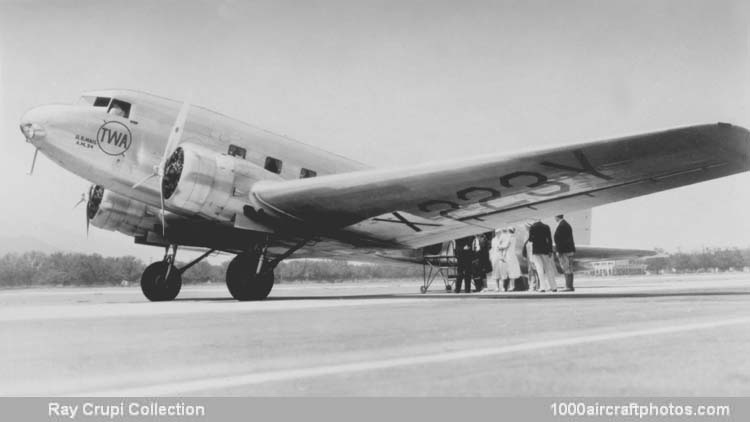02/28/2011. Remarks by Jack McKillop: "On February 1, 1929 the United Aircraft and Transportation Corp. was formed as a holding company for the Boeing Airplane Company, Chance Vought Corp., Hamilton Metalplane Division, Boeing Aircraft of Canada, Stout Airlines, Northrop Aircraft Corp., Stearman Aircraft Co., Sikorsky Aviation Corp., Standard Steel Propeller Co. and Pratt & Whitney Aircraft Co. Several airlines were owned by United Aircraft and on July 1, 1931 they were organized as United Air Lines.
Boeing began work on their Model 247, a twin-engine, all-metal transport, and it made its first flight on February 8, 1933. When production began, the first 59 of 60 aircraft had been ordered by United Air Lines. When other airlines approached Boeing about purchasing 247s, they were told they would have wait until the United order was fulfilled.
Jack Frye, president of Transcontinental and Western Air (TWA), wrote a letter to all the leading manufactures defining TWA's requirements for an all-metal, three-engined airliner that could carry 12 people in comfort. Donald Douglas, head of Douglas Aircraft Co. Inc. of Santa Monica, California, responded and after many discussions, they agreed on a twin-engine aircraft and a contract was signed on September 20, 1932 for one Douglas Commercial Model One (DC-1) costing US$125,000 (US$2 million in 2011 dollars). This aircraft, identified as a DC-1-109, made its first flight on July 1, 1933 from Clover Field, Santa Monica with the experimental registration NX223Y. This was the only DC-1 built.
TWA accepted the aircraft on September 15, 1933 with the restricted registration NR223Y and fleet number 300 and it made a new two-stop transcontinental flight of 13 hours 4 minutes on February 19, 1934. Beginning in April 1934, this aircraft, now registered NC223Y, was flown on the New York to Pittsburgh, Pennsylvania route until it was retired from passenger service in 1936. It was then loaned to the US government, registered NS223Y, for high-altitude research work above 20,000 ft (6,096 m).
In September 1936, it was sold to Howard Hughes, the American aviator, engineer, industrialist, film producer, director and philanthropist, who was planning to use it on a round-the-world flight in 1938. However, he chose to make the flight in a Lockheed Model 14 Super Electra and the DC-1 was sold to Viscount Forbes the Earl of Granard in England on May 27, 1938. It was registered G-AFIF in June and awarded a CofA in July. In October, he sold it in France and it was resold in November to the Spanish Republican Government, registered EC-AGN and operated by LAPE (Lineas Aereas Postales Espanoias Zona Rojas).
The Spanish Civil War ended in April 1939 and this aircraft was acquired by the Spanish Nationalist Government in May and reregistered EC-AAE and named 'Manuel Negron'. In July 1940, Iberia (Lineas Aereas de Espana) of Madrid was formed to takeover LAPE and this was one of the five aircraft assigned to the new airline. While flying passengers service in Spain, this aircraft made a forced landing at Malaga Airport in December 1940 and was damaged beyond repair."
